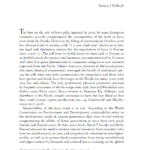A Summary and Commentary of: “Sustainability of the Kava Trade” By Nancy J. Pollock. 2009

Citation:
Pollock, Nancy J. 2009. “Sustainability of the Kava Trade.” The Contemporary Pacific 21 (2): 265–97. https://doi.org/10.1353/cp.0.0070.
Quick Excerpt:
The term kava is used for both the plant Piper methysticum and the beverage made from the plant. Kava is regarded as a pleasurable social drink, and individuals rarely drink it alone. It has attracted the attention of pharmaceutical manufacturers for its soothing, relaxing qualities.
Full Summary:
Kava, scientifically known as Piper methysticum, is more than just a plant; it’s a cultural cornerstone, a medicinal herb, and an economic asset. Native to the Pacific Islands, kava has been used for centuries for its unique properties. The root of the kava plant is typically pounded or chewed and then mixed with water to produce a beverage. This drink, known for its bitter taste, has been traditionally consumed in ritualistic settings, usually by senior men in the community.
In Pacific communities like Vanuatu, Fiji, Tonga, and Pohnpei, kava holds a special place. It’s not just a beverage; it’s a symbol of social cohesion, respect, and community. The plant is deeply integrated into the social fabric of these societies. Kava is often used in ceremonies that honor high-ranking individuals or even gods. In Tonga, for example, kava ceremonies are a significant part of royal events. During these ceremonies, the beverage is served in a specific order to honor the status of everyone seated in the kava circle, which is usually a U-shaped formation.
But kava is not just for formal ceremonies. It has also been used informally and medicinally. Traditionally, both men and women have used kava to relieve various ailments such as urinary problems, colds, and headaches. The plant has even been used to treat impotency. While the physiological effects of kava are not as pronounced as those of some other substances, it does make people feel relaxed and well-disposed toward their surroundings. This soothing, relaxing quality of kava has attracted the attention of pharmaceutical companies, especially since the 1980s.
The pharmaceutical interest in kava has led to a shift in how the plant is viewed. It has elevated kava from being a cultural symbol to becoming a subject of medical research and commercialization. Pharmaceutical companies saw the potential of kava in the rapidly expanding market for herbal alternatives to prescription medicines. This has led to an increase in the trade of kava, not just within the Pacific Islands but also globally.
However, the commercialization and global trade of kava have also led to some challenges. One significant challenge was the Australian government’s decision to ban kava in 2007. The ban was implemented due to health concerns in Aboriginal communities where kava was introduced as an alternative to alcohol. This ban has had a ripple effect, affecting the availability of kava in Pacific communities residing in Australia and impacting the trade relations between Australia and Pacific Island nations. As of 2020 this ban is tentatively removed, and kava is now allowed as a tradable commodity in the Australian market.
In Tonga, kava has become a lucrative cash crop, contributing significantly to the economy. The European Union’s ties with Tonga have even led to pharmaceutical companies tapping into Tonga as an additional source of kava for trade. This has opened up new avenues for economic development in Tonga, where kava plantations have been increasing by about 20 percent per year.
The sustainability of the kava trade is a complex issue. It’s a balance between maintaining the availability of resources for both social and economic benefits and ensuring that these benefits accrue locally as well as globally. The trade of kava has implications that go beyond the Pacific Islands; it’s a global issue that requires careful consideration and sustainable practices.
In summary, kava is a multifaceted plant that plays various roles in society. Its cultural, medicinal, and economic significance cannot be overstated. As kava continues to gain global attention, especially in the realms of medicine and trade, it’s crucial to approach its cultivation, consumption, and commercialization in a manner that is both sustainable and respectful of its deep-rooted cultural significance.
Notes:
- Kava is both a plant and a beverage.
- It has cultural, medicinal, and economic significance.
- The plant has attracted pharmaceutical interest.
- Regulatory challenges did exist, such as the Australian ban. In 2020 this is no longer the case with the Australian Kava Pilot.
- Kava contributes to the economy of Pacific Island nations like Tonga.



